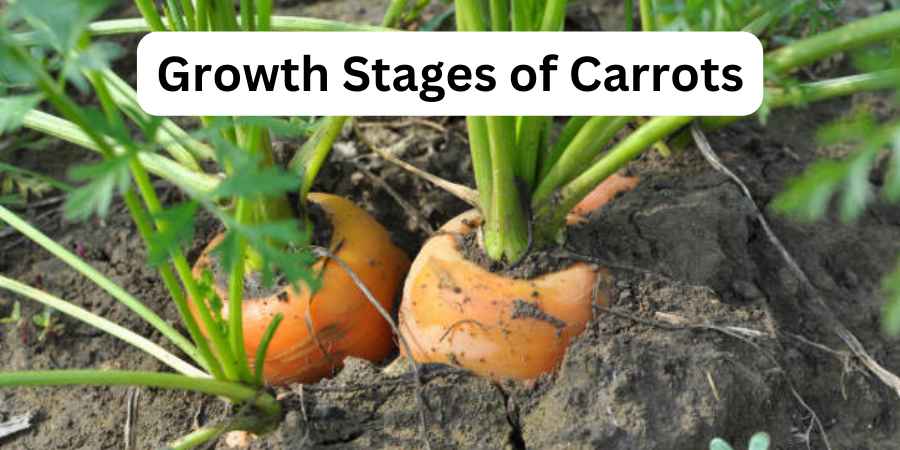Last Updated on June 19, 2025 by Jocelyn
Growing carrots begins with tiny seeds planted in loose, nutrient-rich soil. These root vegetables from the Apiaceae family need consistent moisture and cool temperatures for proper development. Germination usually takes 7 to 21 days, depending on conditions.
As the seedlings grow, leafy rosettes appear above ground while the taproot forms below. Full sun supports stronger growth. Raised beds or containers often improve shape by minimizing soil compaction.
When mature, carrots develop a rich orange color and crisp texture. They do not show clear signs of ripeness, so checking days since planting or gently pulling one can help determine harvest time. A well-timed harvest enhances taste and uniformity.
Table of Contents
ToggleMastering the 5 Growth Stages of Carrots
Each stage, from germination to maturity, demands specific care and attention. By understanding these stages, you can cultivate carrots that are robust, flavorful, and ready to enjoy.
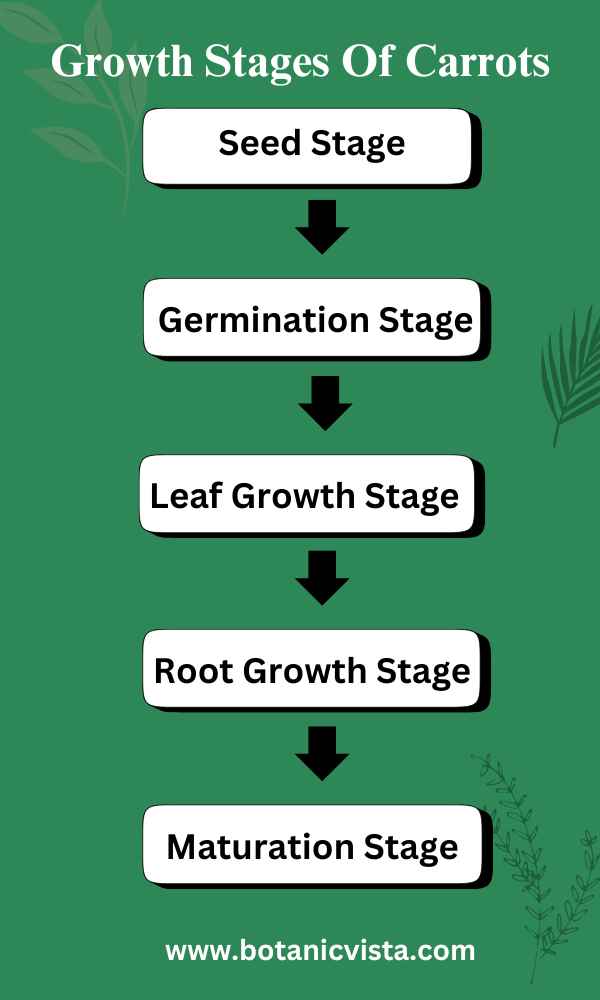
1. Seed Stage
Carrot seeds are tiny, oval, and brown. Selecting the right seeds is crucial for successful growth. Look for seeds that are uniform in size and color, avoiding any that are black or damaged. Proper seed selection ensures strong and healthy seedlings.
When planting, make sure the seeds are placed at the right depth in the soil, about a few millimeters deep. Exposure to light and adequate water will help the seeds sprout.
As they absorb moisture, the radicles emerge and begin the growth process. This careful attention to the seed stage sets the foundation for the carrot’s future development.
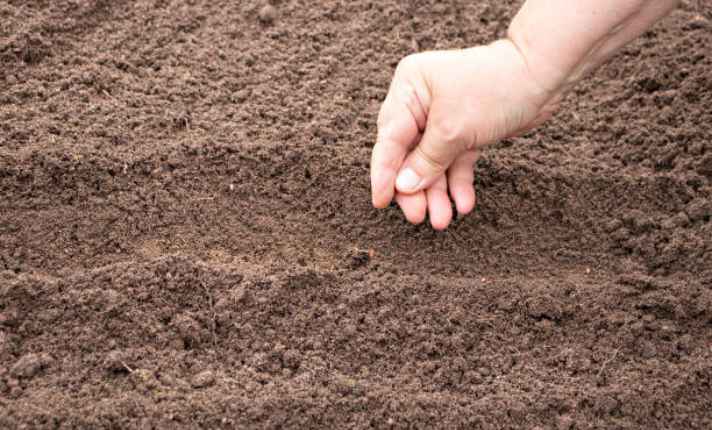
2. Germination Stage
When carrot seeds are planted, patience is needed. In about 14 days, the seeds will start germinating if the temperature is between 60-70°F. Sowing the seeds at a depth of 1/4 inch in peat moss can help.
Moisture is key during this stage. The soil should stay damp but not rot the tiny seeds. Proper soil nutrients are vital for sprouting. Cover the seeds lightly and keep them warm.
Emergence starts with the appearance of delicate shoots. These seedlings will have fern-like cotyledons at first. As they grow, true leaves will form, signaling the next growth stage. Cracking the soil gently with a tool can help tiny roots.
Planting in the afternoon can help with better softening of the soil. Watching these delicate seedlings transform into tough carrot plants is amazing!
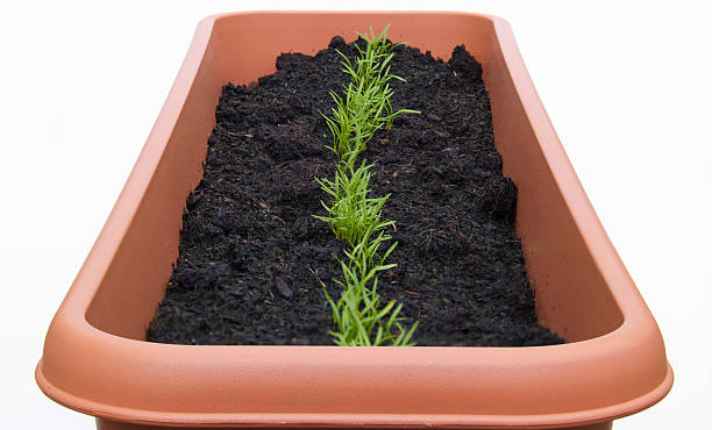
3. Leaf Growth Stage
When you sow carrot seeds, they first sprout cotyledons, the tiny first leaves. In 1.5 to 3 weeks, you will see the first true leaves. It’s important to do regular inspections to check for pests and ensure plants get sufficient nutrients from the soil.
From my experience, thinning the small carrots early helps them grow larger and healthy. People often forget this step, but it’s key to a successful harvest. One time, skipping thinning resulted in miniature carrots.
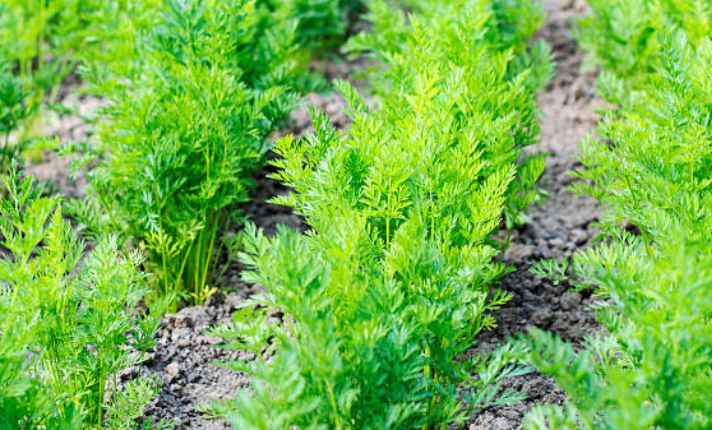
4. Root Growth Stage
Carrots form a taproot that grows deep into the soil. In the early stages, it is thin and tapered.
Carrots are unique vegetables with a characteristic root that develops over several periods until maturity. Proper care is essential as they are sensitive to secondary nutrient needs.
The typical carrot plant grows below the surface and needs the right conditions to develop well. With enough energy, it can produce a healthy root. Without it, the root may become stunted or elongated.
Carrots are important primary vegetables needing protection from drought. During dry weather, their growth can suffer. Keeping the soil moist helps promote good growth.
Anchor days for a good crop are usually 70-80. Different varieties of carrots can have different shapes. Maintaining proper moisture ensures they grow straight and healthy beneath the soil.
In prolonged dry periods, roots absorb fewer nutrients, leading to a stunted appearance.
Regular watering helps the soil stay moist, allowing carrots to get the nutrients they need for proper growth and shape.

5. Maturation Stage
As carrots reach full maturity, the transformation in their color becomes evident. Depending on the variety, colors range from vibrant orange to purple, red, yellow, and white.
These hues indicate an increase in carotenoids and beta-carotene, crucial pigments that signal readiness for harvesting.
The root shape of mature carrots also becomes more defined, typically elongated with a tapering tip. The taproot feels plump and firm, showing they are ready to be harvested.
The top growth of lush green leaves efficiently channels energy into the root, which stores sugars and prepares for harvest. This stage highlights the diversity in size and thickness achievable under ideal conditions.

How to Harvest Carrots?
To harvest carrots effectively, choose a cool part of the day to maintain freshness. Inspect the soil where the carrot tops protrude about an inch. This visibility indicates readiness.
Carefully wiggle the greens at their base and pull straight up. If resistance is felt, a garden fork can be used to gently lever the carrots from the ground, preventing them from breaking.
Once harvested, remove excess soil and rinse the roots. Allow them to dry thoroughly before storage, ensuring they remain usable through winter when the ground freezes.
Timing is critical for harvesting. Early harvests yield small carrots, while late ones risk freezing ground, making extraction challenging without breaking the carrots.
Testing a row or cluster first can confirm the size and reduce soil disturbance for unharvested plants.
6 Useful Carrot Cultivation Tips
Growing carrots successfully hinges on knowing their specific needs, from soil conditions to the appropriate climatic environments.
Let’s explore the essential steps that can help maximize your carrot crop.
1. Soil Preparation
To ensure the best growth for carrots, start with fertile, well-drained, deep sandy soils. It’s important to make the soil loose and fluffy with a pH between 6.0 and 7.0.
Double-digging the soil and incorporating organic matter such as compost can greatly enhance root development. A soil test should be conducted to get precise fertilizer recommendations based on the test report.
2. Fertilization
Carrots benefit from careful fertilization. About 6 weeks after seed emergence, apply ¼ cup of nitrogen-based fertilizer (21-0-0) per 10 feet of row.
This helps in rapid plant growth while avoiding excessive nitrogen, which could promote too much foliage and not enough root development.
3. Water Management
Watering carrots regularly is crucial, especially in sandy soils where moisture can fluctuate quickly. Aim for moist, uniform soil conditions without over-watering, as this can lead to root disorders like forking or hairy roots.
Using drip irrigation helps maintain consistent moisture levels and prevents the soil from drying out.
4. Spacing and Thinning
Seeds should be sown ¼ inch deep and thinned to 3-4 inches apart once the seedlings have 3-4 true leaves. Proper spacing is critical for adequate air circulation and nutrient availability for each plant, promoting healthy growth and development.
5. Temperature and Climate Conditions
Carrots grow best in a temperature range of 40-80°F. High summer temperatures above 80°F can reduce seed germination, while temperatures below 32°F can seriously damage the plants.
Partial shade can be beneficial in areas with strong direct sunlight to prevent overheating.
6. Mulching
Using organic mulch such as sawdust, straw, pine needles, or leaf mold helps conserve soil moisture and maintain even soil temperatures. Mulching also reduces weed pressure and minimizes moisture fluctuations, which are common in unevenly watered gardens.
Common Challenges in Carrot Growth
Good soil, enough water, and the right space help carrots grow well. Checking the plants often helps stop problems with pests and diseases.
| Challenge | Causes | Preventive Measures |
| Fungal Infections | High humidity, poor soil quality | Ensure good drainage, use wood ashes to reduce diseases |
| Pests | Carrot rust fly, carrot weevils, aphids | Use crop rotation, apply monitoring for eggs and larvae |
| Nematodes and Slugs | Wet soil, over-crowded plants | Improve spacing, thinning to avoid stunted growth |
| Blight and Powdery Mildew | Pathogens in air, watering issues | Vigilance in watering, avoid foliar diseases |
FAQ’s
Q: Why Do Carrots Take So Long to Grow?
A: Carrots are slow to grow, especially in cooler spring temperatures, as they need about 70°F to germinate well. Warmer conditions later in the season help the roots expand and develop their sweetness and size.
Q: Do Carrots Come back Every Year?
A: Carrots are biennials, meaning they live for two years. They grow roots in the first year and produce seeds in the second year, so they do not come back every year. Carrots complete their life cycle in two years.
Q: What Do Carrots Look Like When They First Emerge?
A: When carrots first emerge, they have two small, grass-like leaves. These leaves are thin and frilly. As they grow, the plants will develop fern-like leaves, which look very different from the initial ones.
Q: Do Carrots Grow Well in Raised Beds?
A: Yes, carrots grow well in raised beds. Raised beds provide the ideal conditions for carrots. They allow for good drainage and control over the soil quality.
With deep and wide beds, at least 12 inches, you can accommodate the long roots of carrots. This setup makes it easy to maintain and harvest the carrots when they are ready.
Conclusion
Growing carrots is a satisfying journey. From tiny sprouts to mature roots, each stage requires dedication and effort. As an experienced gardener, I’ve found that the effort put into sowing and watching them grow is truly enjoyable. Homegrown carrots, with their brightest colors and delicious taste, make all the challenges worthwhile.
Learn more:
